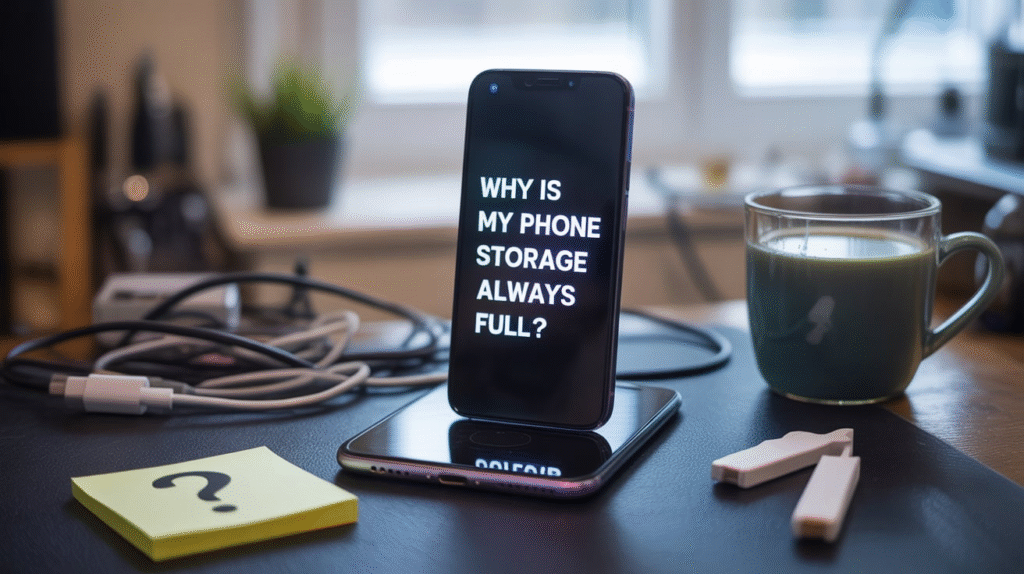If your phone constantly warns you about low storage even after deleting apps or moving files, it’s not just frustrating; it can affect performance. Failed app updates and the inability to take photos or download documents are common issues. What fills up your storage isn’t always obvious. System files, app caches, hidden downloads, and duplicated media can silently consume space over time.
Even background processes like automatic backups or messaging apps may be storing large files without your knowledge. Understanding what’s really using up space is the first step toward resolving it. Here are the most common reasons your phone stays full and what steps to take for a proper cellphone fix.
Reasons for Full Phone Storage
Here are some reasons why your phone storage is always full:
1: App Cache and Temporary Files Build Up
Apps often store temporary files that build up over time. They save little bits of data to help themselves open faster. At first, it’s fine, but over time, these bits add up without you realizing. Apps like Instagram, YouTube, and even your browser can eat up a chunk of space with these hidden files. The good news? You can clear these out without losing anything important. On many Android devices, you can fix this by opening the Settings, then Storage, then Apps, and tapping “Clear Cache.” For iPhone users, sometimes you need to delete the app and reinstall it to clear out the clutter.
2: Photos and Videos Take Up More Space Than You Think
We love taking photos and videos, but these memories take up significant space. High-quality pictures and 4K videos can fill your phone before you know it. Screenshots, duplicates, and photos from messaging apps sneak into your storage, too. Many people forget to empty the “Recently Deleted” folder, which still takes up space until you clear it. Using cloud services like Google Photos or iCloud can help though these services may require subscriptions for additional storage. This way, you can keep your photos while freeing up your phone for the moments you want to capture next.
Read Also >>> Top 6 Methods to Factory Reset iPhone
3: Hidden Downloads and Offline Files Accumulate
Here’s the thing: files you download through emails or messaging apps don’t always disappear after you view them. They often sit in hidden folders, quietly taking up space. If you save songs or shows offline on apps like Netflix or Spotify, these files can build up, too. Take a few minutes to check your Downloads folder and look inside apps to clear offline files you no longer need. You’d be surprised how much room this frees up. You can also reach out to cellphone experts to help you get rid of the hidden files.
4: Messaging Apps Store a Lot of Media
Messaging apps are wonderful for staying connected, but they’re also champions at clogging your storage. By default, apps like WhatsApp and Telegram download every photo and video sent to you, often saving them twice in your app and gallery. Over time, this piles up into gigabytes of data. To handle this, go into each app’s settings and clear out old chats and media. You can also turn off automatic downloads so you can save only what truly matters to you.
5: Too Many Unused Apps and App Data
We’ve all downloaded apps we needed for a moment, then forgot they existed. These apps take up space even when you don’t use them. Some apps you use often, like editing tools or note apps, store a lot of hidden data, too. Every so often, scroll through your app list and delete anything you haven’t opened in weeks. If you’re on Android, you can move some data to an SD card if your device supports SD cards. On iPhone, you can use the “Offload Unused Apps” feature, which removes apps but keeps your data safe.
6: System Files and OS Updates Expand Over Time
Some updates can leave behind residual files or logs, especially on older devices. Keeping your phone updated can help clear out some old files. If you have an Android, clearing the cache partition helps remove leftover system clutter. If you use an iPhone, using built-in cleanup options can help your phone manage space better.
7: “Other” Storage Category Grows Unnoticed
When you check your phone storage, you may see a section called “Other” or “System Data.” This can include browser data, app files, saved messages, and logs. It’s tricky because you can’t clear it all at once. However, you can reduce it by deleting browser history, clearing app downloads you don’t need, and resetting device settings when needed. Or seek help from a professional cellphone technician. Every bit helps to give your phone some relief.
Read Also >>> Samsung Charging Icon, But No Power? Try These Fixes Now
Conclusion
Constant full-storage warnings are often caused by factors users can control, such as cached data, background downloads, duplicate media, and oversized app storage. Manually clearing app caches, deleting unused files, reviewing media folders, and adjusting backup settings can free up several gigabytes. Hidden files and settings like automatic downloads or high-resolution formats also play a big role. Understanding what your phone stores and how it handles files is key to solving the issue in the long term. If storage issues persist even after cleanups, consider moving files to external storage or cloud services. For devices with persistent software bloat or system file buildup, a professional cellphone fix may be needed to fully restore storage capacity.


